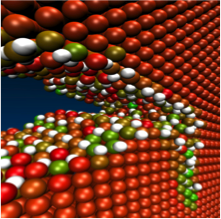Hydrogen embrittlement is pervasive in many classes of structural metals. Hydrogen has many different effects on plasticity in metals, with different effects in different materials, making it difficult to identify fundamental mechanisms and origins of embrittlement. The field thus has many proposed concepts, based mainly on experimental observations. Our general goal has been to use atomistic simulation methods to study proposed effects of Hydrogen, so as to put proposed concepts on a firm atomistic foundation if possible. Atomistic simulations have limitations, and so are also not definitive.

We have also developed a new concept for Hydrogen embrittlement, in which H aggregation around a crack tip prevents crack tip blunting by dislocation emission, which is an important precursor to global ductile failure. Without blunting, cracks remain sharp and ultimately propagate by cleavage. H around the crack tip can actually diffuse along with the growing crack in a slow-crack-growth mode to continue crack growth. Atomistic simulations in both Ni-H and Fe-H have verified this mechanism. We have developed an additional kinetic model to connect this atomistic-scale mechanism to the larger-scale time- and load-dependent transport of H to the crack tip. Application of the model to predict embrittlement in a range of ferritic steels has been remarkably successful, providing encouragement for further development of the concept. We are currently examining the role of grain boundaries, and H segregation to grain boundaries, on the operation of this mechanism in Fe.
In the more general area of fracture in metals, we have investigated the behavior of atomistic crack tips. In particular, we have shown that whether or not crack tip twinning occurs in an fcc materials is an issue of competing thermally activated phenomena, twinning and full dislocation emission. Multiscale simulations have revealed a time/load transition between twinning and non-twinning in Al. Parallel analytic models based on the Rice analysis of dislocation emission have been developed, and these models explain the twinning trends found across the fcc metals.
Currently, we are using our new Mg interatomic potential to investigate the atomistic-scale fracture phenomena for many orientations of cracks in Mg. We find that almost all orientations yield cleavage rather than dislocation emission, and that these results are largely consistent with the predictions from the anisotropic elasticity model of Rice and Beltz. Thus, Mg appears “intrinsically brittle” at T=0K, which drives research into alloying that can alter this tendency.
Key publications:
- D. Warner, W. A. Curtin, and S. Qu, “Rate dependence of crack tip processes predicts twinning trends in fcc metals”, Nature Materials 6, 876-881 (2007)
- D. H. Warner and W. A. Curtin, “Origins and implications of temperature-dependent activation energy barriers for dislocation nucleation in face-centered cubic metals”, Acta Mater. 57, 4267-4277 (2009).
- J. Song and W. A. Curtin, “Nanoscale Mechanism of Hydrogen Embrittlement in Metals”, Acta Mater. 59, 1557-1569 (2011).
- J. Song and W. A. Curtin, “Mechanism of H embrittlement in Fe”, Nature Materials (2013)
Additional work
- J. Song, M. Soare, and W. A. Curtin, « Testing continuum concepts of hydrogen embrittlement using atomistics », Mod. Sim. Matls. Sci. Eng. 18, Art#045003 (2010).
- J. Song and W. A. Curtin, Searching for HELP: Atomistic simulations of H effects on dislocation mobility and pile-ups in Fe, Acta Mater. (2014).
- J. Song and W. A. Curtin, H effects on Nanoindentation in Ni-H, in preparation.
- Z. Wu and W. A. Curtin, Intrinsic brittleness of Mg, submitted to MSMSE (2014).